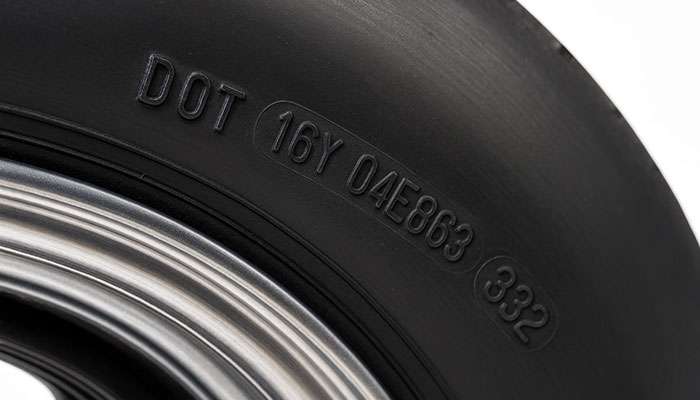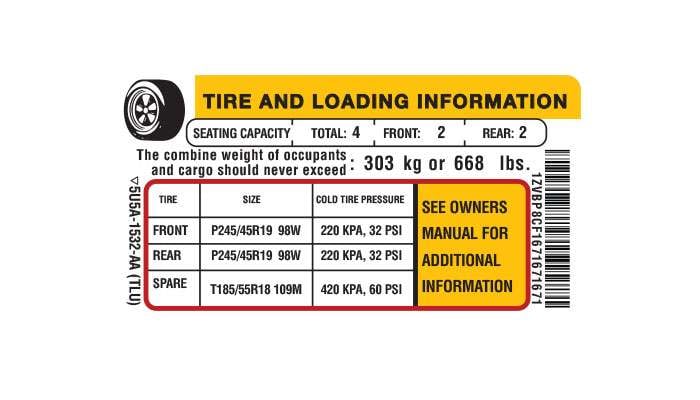
Most tire manufacturers recommend replacing your tires every 6 to 10 years, regardless of tread depth. That's a fact many drivers don't know—and it could save your life.
The small numbers stamped on your tire's sidewall aren't random markings. That DOT tire date code reveals exactly when your tire was manufactured, and it's one of the most important safety indicators on your vehicle. Even when your tires look perfect with plenty of tread remaining, they're quietly aging in ways you can't see.
Rubber compounds break down over time. Steel belts weaken. The fabric layers that give your tire its strength gradually deteriorate. Your tires could be ticking time bombs, ready to fail at highway speeds when you least expect it.
Old tires kill. Beyond losing grip in wet conditions, aging tires develop internal cracks and experience dangerous tread separation—failures that happen without warning at the worst possible moments. Whether you drive a compact car, a performance vehicle, or a heavy-duty truck, knowing how to read these date codes is essential for your safety.
We're going to show you exactly how to decode these critical markings and explain why tire age matters far more than most drivers realize. This simple skill takes just minutes to learn but could prevent a catastrophic accident that changes everything.

The DOT tire date code reveals exactly when your tire was manufactured. This isn't just bureaucratic paperwork—it's critical safety information that directly affects tire performance and safety.
Finding the DOT code takes a few minutes of searching, but it's worth the effort. Every tire manufactured for use in the United States displays the full DOT code on at least one sidewall. For tires made after September 2009, manufacturers place the complete code on the outboard side (facing out) and a partial code on the inboard side.
You'll often need to check both sidewalls since manufacturers sometimes stamp the full code on the inner side where it's harder to see. Look near the rim area for a sequence that starts with "DOT". Can't find it on your mounted tires? Check the tire information sticker inside your driver's door frame for reference.
The DOT code breaks down into specific segments that tell the tire's complete story:
DOT Symbol - These three letters certify compliance with U.S. Department of Transportation safety standards.
Plant Code - The first two or three characters identify the manufacturing facility.
Tire Size Code - The next one or two characters indicate the specific tire size.
Manufacturer's Code - Up to four characters containing internal construction codes.
Date Code - The final four digits show manufacturing date for tires made since 2000.
Here's how it works: A code like "DOT-MA-L9-ABCD-0319" tells you the tire was manufactured during the third week of 2019. The first two digits represent the week (01-52), and the last two show the year.
Older tires manufactured before 2000 use a three-digit system. These codes show the week in the first two digits, but the last digit only indicates the final digit of the year—so "529" could mean the 52nd week of 1989, 1999, or 1979.
Many drivers use these terms interchangeably, but they're different. The complete DOT code includes up to 13 characters following "DOT". This full sequence is technically called the Tire Identification Number (TIN).
The date code specifically refers to just the last four digits of this sequence. The entire DOT code provides manufacturing details, plant information, and construction specs, while the date code portion only reveals the tire's age.
This distinction matters because starting April 13, 2025, all tires must use a thirteen-character TIN format. Retreaded tires get their own separate DOT code from the retread manufacturer, usually placed near the original marking.
Understanding your tire's date code helps you make smart replacement decisions, especially since rubber begins experiencing thermo-oxidative degradation after five years—a chemical process that compromises tire safety.
Reading the markings on your tire sidewall is simpler than most drivers think. Once you understand the system, decoding these critical safety numbers takes just seconds. Here's exactly how to do it.
Finding your tire's manufacturing date requires a systematic approach:
Locate the complete DOT code on your tire's sidewall - it appears after the letters "DOT" followed by 10-12 characters
Focus on the last four digits of this sequence - these reveal exactly when your tire was manufactured
Split these four digits into two groups of two numbers
The first two digits show the production week (01-52)
The last two digits indicate the production year
For example, "DOT U2LL LMLR 5109" means your tire was manufactured during the 51st week of 2009. A code ending with "3520" indicates production during the 35th week of 2020.
The dating system works consistently for all tires made since 2000:
First two digits: Week of production (01 to 52)
Last two digits: Year of manufacture (last two digits of the calendar year)
This system provides precise dating. "2516" means production during the 25th week of 2016. If your DOT code ends with "1319," your tire was manufactured in the thirteenth week of 2019.
Think of the date code as your tire's birth certificate. This information matters because safety experts recommend replacing tires every 6-10 years regardless of tread depth due to natural rubber aging.
Tires manufactured before 2000 use a different system:
A three-digit code appears at the end of the DOT number
First two digits represent the week of manufacture (01-52)
The third digit shows only the last digit of the year within the decade
If you see "229," the tire was made during the 22nd week of a year ending in "9" - which could be 1999, 1989, or 1979. There's no way to determine the exact decade without additional context.
This confusion is why the system changed to four digits in 2000. If your tire has only a three-digit date code, replace it immediately regardless of condition. These tires have far exceeded safe service life and pose serious safety risks.
Most drivers check tread depth and think they're done. They're missing the bigger picture. Tire age is the silent killer that no amount of remaining tread can fix.
Tires undergo a chemical process called thermo-oxidative degradation as they age. Oxygen attacks the rubber compounds, causing them to harden and lose flexibility. The material becomes brittle and develops internal cracks that you can't see from the outside.
Heat accelerates this aging dramatically. Tires in Phoenix age approximately 2.5 times faster than those in Detroit or Hartford. UV light, ozone, and constant temperature cycling further break down the rubber compounds. This happens whether you drive 50,000 miles or 5,000 miles per year.
Steel belts weaken. Fabric reinforcement layers deteriorate. The chemical bonds that hold your tire together gradually fail, regardless of how much tread remains on the surface.
Aged tires fail in predictable ways:
Tread separation – Steel belts detach from the tire body
Sudden blowouts – Sidewalls lose structural integrity
Reduced traction – Especially dangerous in wet conditions
Longer stopping distances – Compromised braking performance
Loss of vehicle control – Particularly at highway speeds
Safety researchers documented over 250 incidents where tires older than six years experienced tread and belt separations, resulting in 233 fatalities and 300 injuries in 2012 alone. These failures happen without warning when internal degradation reaches critical levels.
Major tire manufacturers acknowledge these aging risks. BFGoodrich, Bridgestone, Continental, Goodyear, Hankook, Kumho, Michelin, and Yokohama have all issued tire age service bulletins.
Automakers are even more conservative. Ford, Nissan, and Mercedes-Benz recommend tire replacement six years after production date regardless of tread life. Continental and Michelin extend this to 10 years maximum.
At Performance Plus Tire, we recommend professional tire inspection after five years, then annually thereafter. Our experienced technicians understand how aging affects different tire compounds and can identify potential problems before they become dangerous. The DOT date code gives you the facts you need to make informed decisions about tire safety.

Your DOT tire date code does more than reveal age—it's your key to safety recalls and warranty claims. When manufacturers discover defects or you need warranty service, this unique identifier becomes essential for getting the protection you deserve.
Your tire's complete DOT code serves as its fingerprint for recall identification. Here's how to check:
Find the full DOT code on your tire sidewall
Write down all numbers and letters that follow "DOT"
Go to your tire manufacturer's website or call their customer service
Enter the complete DOT code into their recall search tool
Tires are required by federal law to display the full TIN on one sidewall and may show only a partial code on the other. Always use the complete code that includes the date portion for accurate identification.
Checking for tire recalls is easier than most drivers realize:
The United States Tire Manufacturers Association (USTMA) provides a dedicated recall search tool. Simply enter your tire's DOT code to instantly check if it's subject to a recall by any USTMA member company. The database updates regularly as manufacturers announce new recalls.
The National Highway Traffic Safety Administration (NHTSA) offers a comprehensive safety recall lookup system through their website and mobile app. NHTSA's database covers all vehicle equipment including tires from various manufacturers. Their SaferCar app can even send automatic alerts about new recalls affecting your registered tires.
When you submit warranty claims, the DOT code provides crucial proof:
Authentic manufacturing origin of your tire
Exact production date for age-related warranty calculations
Compliance with transportation safety standards
This information becomes vital when seeking coverage for premature wear, manufacturing defects, or road hazards. Most warranty policies require the DOT code for processing claims.
At Performance Plus Tire, our experienced technicians can help interpret your DOT code and determine if your tires qualify for recall repairs or warranty coverage. We understand the complexities of tire identification and can guide you through the process to ensure you get the coverage you're entitled to.
Once you know your tire's age from the DOT date code, proper maintenance becomes essential for getting the most life and safety from your investment. These practices help protect your tires and maximize their performance throughout their service life.
Store seasonal tires correctly to prevent premature aging. Place them in clean, airtight plastic bags with the air removed to prevent oil evaporation from rubber compounds. Find cool, dry storage areas with moderate ventilation, keeping tires away from direct sunlight that accelerates the aging process.
Avoid areas near electric motors that produce ozone, including furnaces, central vacuums, and sump pumps. For mounted tires, hang them from hooks through the rim. Store unmounted tires standing upright.
Check tire pressure monthly—underinflated tires generate dangerous heat that leads to failure. Tires naturally lose about 1 PSI per month. Always check pressure when tires are cold, using your vehicle's doorjamb sticker rather than the sidewall for correct specifications.
Look for uneven wear patterns during inspections, which often signal alignment problems. Catching these issues early prevents accelerated tire wear and maintains optimal performance.
Rotate tires every 5,000-8,000 miles according to your owner's manual. This redistributes wear evenly across all four tires by changing their positions. Schedule wheel alignments every 6,000-10,000 miles to ensure tires contact the pavement at proper angles.
At Performance Plus Tire, we can professionally handle both services to maximize your tires' lifespan and maintain optimal performance throughout their service life.
Understanding DOT tire date codes comes down to protecting yourself and your passengers on the road. That four-digit code stamped on your sidewall tells you everything you need to know about when to replace your tires, regardless of how good they look on the surface.
The format is simple to remember. First two digits show the manufacturing week (01-52), and the last two digits indicate the year. If you find a three-digit code on your tires, those were manufactured before 2000 and need immediate replacement.
We recommend replacing tires every 6-10 years based on manufacturer guidelines, though hot climates can accelerate aging significantly. Rubber breaks down naturally over time, making even good-looking tires vulnerable to sudden failure.
Your DOT code serves another important purpose beyond age verification. These numbers help you check for safety recalls through NHTSA databases and provide essential information for warranty claims. When manufacturers discover defects affecting specific production batches, your DOT code determines if your tires are included.
Proper maintenance extends tire life once you know their age. Monthly pressure checks, correct storage practices, regular inspections, and timely rotations help maximize safety and performance. While you can't stop the aging process, these practices ensure you get the best value from your tire investment.
At Performance Plus Tire, our experienced technicians can help you decode DOT markings and determine the right replacement schedule for your driving conditions. We carry the best selection of quality tires at competitive prices to keep you safe on the road.
Check those DOT codes the next time you're near your vehicle. This simple habit could prevent a dangerous blowout and keep you and your family safe.
Understanding your tire's DOT date code is a critical safety skill that every driver should master to prevent dangerous tire failures.
• Find the 4-digit code on your tire sidewall - The last four digits after "DOT" reveal manufacturing week and year (e.g. "3520" = 35th week of 2020)
• Replace tires every 6-10 years regardless of tread depth - Rubber degrades over time through chemical processes, making old tires prone to blowouts
• Use DOT codes to check for recalls and warranty claims - Enter your complete DOT number into NHTSA or manufacturer databases to verify safety recalls
• Tires with 3-digit codes need immediate replacement - These were made before 2000 and have exceeded safe service life limits
• Environmental factors accelerate tire aging - Heat, UV exposure, and ozone can make tires age 2.5 times faster in hot climates
Remember: Your tire's age matters more than its appearance. Even tires with perfect tread can experience catastrophic failure if they're too old, making DOT date code knowledge essential for road safety.
The DOT tire date code is a 4-digit number found on the tire sidewall. The first two digits indicate the week of manufacture (01-52), and the last two digits represent the year. For example, "2516" means the tire was made in the 25th week of 2016.
Most tire manufacturers recommend replacing tires every 6-10 years, regardless of tread wear. However, factors like climate and storage conditions can affect tire lifespan, so regular inspections are important.
Tire age matters because rubber degrades over time, even if tread depth is adequate. This degradation can lead to reduced performance, decreased safety, and increased risk of blowouts or tread separation.
You can check for tire recalls by entering your tire's full DOT code into the NHTSA's safety recall lookup tool or your tire manufacturer's website. This helps ensure you're not driving on potentially unsafe tires.
To extend tire life, store tires properly in cool, dry areas away from sunlight and ozone sources. Perform regular pressure checks, rotate tires according to the vehicle manufacturer's recommendations, and schedule wheel alignments as needed.